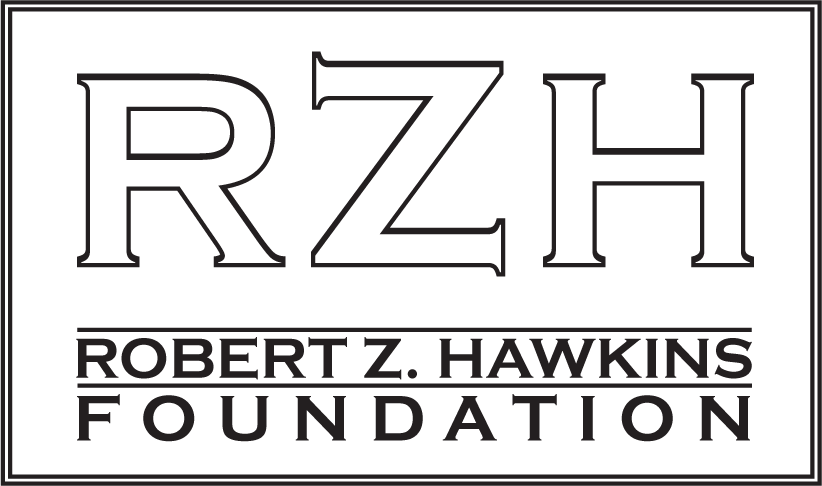About the Oats Park Art Center
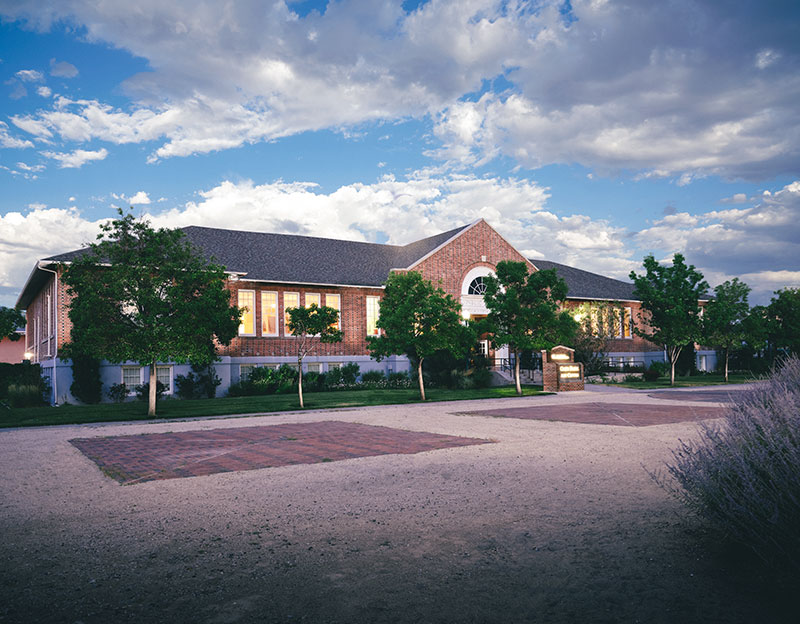
Oats Park Art Center, Fallon, Nev.
Efforts to provide a permanent home for the Churchill Arts Council’s programs began with a series of community and regional meetings in 1989, which identified the historic Oats Park School building in Fallon as a potential candidate to house a multi-discipline community arts center. The structure was nominated to the Nevada and National Registers of Historic Places in 1990 and a Feasibility/Concept Study was commissioned and completed in 1992. The Study was extremely positive about returning the building to community use and – thanks to funding from the National Endowment for the Arts, Arts Facilities Design Program – a Design Development report was completed in 1993. Construction documents for the entire art center were completed and construction and renovation began in 1996. In July 1999, Oats Park was designated as an Official Project of Save America’s Treasures – a public-private partnership of the White House Millennium Council and the National Trust for Historic Preservation. As such, Oats Park joined a very select group of historic resources that have been chosen to represent America’s treasures in need of support for their preservation and renovation. To proceed in the most cost effective manner and to accommodate available funding, construction and renovation has been implemented in a series of dovetailing and/or overlapping phases. The theatre opened in 2003, visual art galleries in 2006, and the final portions, including a café and catering kitchen were completed in 2016.
A Complete History of the Oats Park Art Center

Linda Fleming, Installation View (2012), E. L. Wiegand Gallery
Churchill County was formed in February, 1864, just nine months before Nevada became a state on Halloween of the same year. The City of Fallon was incorporated as a municipality in 1908 and in 1909, a ten acre square was deeded to the City, for use as a park, by its owners John and Nellie Oats.
The Oats Park Art Center is sited on a block at the eastern edge of this addition, which was sold by John and Nellie Oats to the Board of School Trustees in July, 1914, for $500. The school was designed that same year by Frederic J. DeLongchamps, Nevada’s preeminent, and most prolific architect of the period, and completed and opened in 1915. His designs are acknowledged as playing a significant role in shaping the architectural character of Nevada in the twentieth century. Between 1907 and 1964 his firm produced architectural drawings for more than 500 structures in Nevada and across the country; more than twenty in Fallon alone.
Oats Park is one of the earliest and perhaps his first public school building. It is significant not only architecturally; but also because of its association with education in Nevada. The original budget – including purchase of the real estate, furnishings and architect’s fees – for construction of the school was $20,000.
After completion of the original school building, the community experienced rapid growth – almost doubling in size between 1909 and 1912. This was due to the impact of the Newlands Reclamation Project, which enabled extensive irrigation of the area, leading to an agricultural bonanza, the copious green fields of alfalfa, giving the region its nickname, “The Oasis of Nevada.”
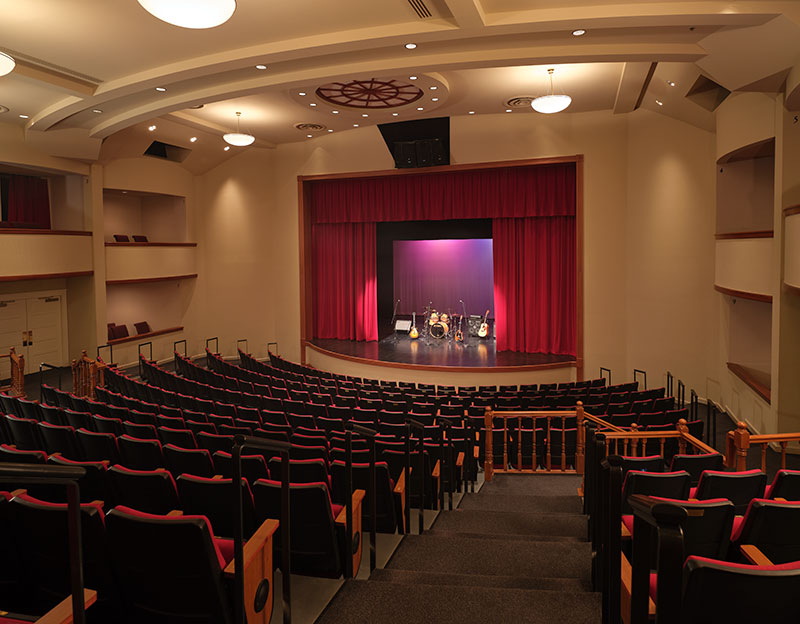
Barkley Theatre, Oats Park Art Center, Fallon, Nev.
The school was enlarged in 1921, following DeLongchamps’ proposals for adding north and south wings to the building. Each of these added two new classrooms capable of accommodating fifty students. The architect’s original plans for the additions also included a theatre space, with a raised stage and a motion picture room, which the architect alluded to as the technology of the future. But due to school district budget concerns, these innovative features were not implemented.
The school served the community for many years, first as a grammar school and then as a junior high school for seventh, eighth and ninth grades beginning in 1957. The building had been slightly damaged in the earthquakes of July and August of 1954, the most significant impact being the loss of the historic fan window over the pediment of the main entryway. This was plastered over and remained lost to view for many years. The building was closed for use as a school in the early 1970s, but continued to be used for both storage and classroom space for students of the then-fledgling Western Nevada College.
In the late 1970s, the school district commissioned a study to determine the feasibility of potentially restoring the building for use as a school. The report – which did not identify the architect or his original plans – indicated that while it might be possible to restore the structure for use as a school, it might be cost prohibitive to do so. Based on this report the building was closed for all school activities and used exclusively for storage.
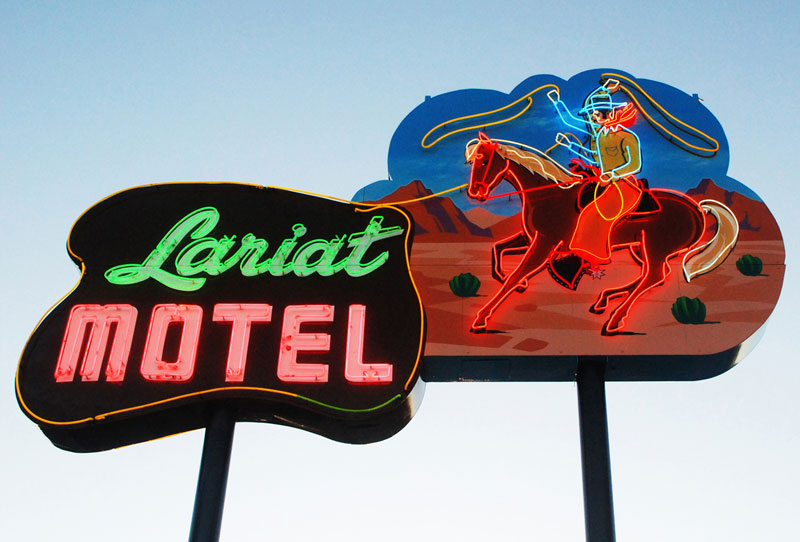
Historic Highway 50 Lariat Motel neon sign
Oats Park Art Center, Fallon, Nev.
The Churchill Arts Council was founded in 1986 and presented its first performances that same year. Over the years, the Council’s programming has grown to include a full season of ticketed performances, free in-the-park concerts co-sponsored with the city, visual art exhibitions of regional and national artists, a classic film series, artists’ residencies in the schools and many other cultural activities. From its inception CAC has been interested in creating a permanent home for the arts and cultural activities right here in Fallon, where both residents and visitors can have direct access to high quality artistic experiences. Initially, performances were presented in a variety of venues around town from the Fallon Convention Center to the High School Theater, Fallon Elks Lodge and the Livestock Sale Yard. Exhibitions were installed at the County Library, the gallery at Western Nevada College and other venues. Throughout this period, CAC continued to explore the options and possibilities for establishing a permanent home for the arts in Fallon and was designated as the official arts advisory agency for the City of Fallon in 1991 and Churchill County in 1994.
Through an extensive series of meeting with various groups and individuals in the community it was determined that the strongest candidate, and most achievable financially, for an art center might be the Oats Park School building. In consultation with the city and school district, CAC successfully placed the structure on the Nevada and National Registers of Historic Places in 1990, and completed a feasibility/concept study on adaptive re-use of the building in 1992. Design development was aided by a grant from the Design Arts Program of the National Endowment for the Arts, the only such grant awarded in Nevada and one of only seven awarded in the entire country.
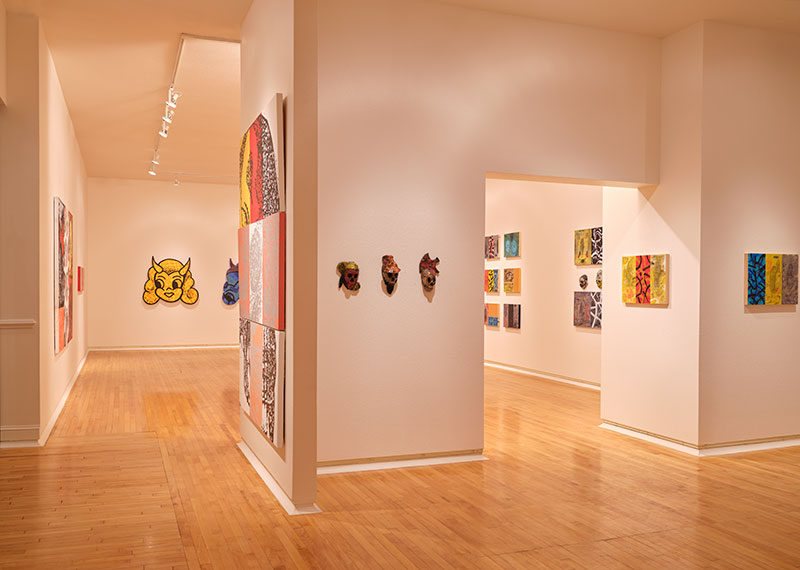
Michael Sarich, Installation View (2020), E. L. Wiegand Gallery
In 1995, the City of Fallon designated the block on which the school is sited as the Oats Park School Historic District and the Council approached the Churchill County School District with a proposal for the adaptive re-use of the building. The School Board voted unanimously to turn the building over to CAC under a long term lease in 1996 and construction and renovation began that year.
Initial construction efforts focused on structural stabilization of the entire building to insure integrity of subsequent renovations. To accommodate available funding and proceed in the most cost effective manner, renovation and construction were implemented in a series of overlapping, dovetailing phases, each one building on a previously completed work.
The structure was also designated as as Official Project of Save America’s Treasures in 1999, a public-private partnership of the White House Millennium Council and the National Trust for Historic Preservation. As a recipient of Save America’s Treasures funding, the Oats Park School/Oats Park Art Center joined a very select group of historic resources that have been chosen to represent America’s treasures in need of support for their preservation and renovation. Due to steady progress on the renovation and completion of $4 million worth of construction and remodeling, the School District turned full title to the building over to the CAC in 2006.

Barkley Theatre, Oats Park Art Center, Fallon, Nev.
Significant milestones in the two-decades-long campaign to complete the adaptive re-use of the building include:
1996: Structural stabilization of the building, re-roofing, and restoration of the central west façade and historic pediment/fan window, which had not been visible since 1954.
1998: Completion of portions of the building’s central core – including entry, lobby, box office, lounge, storage, and hallway areas.
2003: Completion of the Barkley Theatre, which was constructed in the footprint where DeLongchamps had originally proposed a theatre space with raised stage; it opened as a gift to the community on Valentine’s Day. All performing arts presentations move into the building.
2004: Movie screen and projection equipment installed in the theatre, and classic film series begin. Classroom Gallery exhibition space completed in central core.
2006: Completion of the upper level, including the E. L. Wiegand Gallery, boardroom, and south wing permanent collection gallery. All visual arts programming moves into the building.
2008: Lower level restrooms, gallery prep/load-in, library, press, and future admin/office areas on lower level completed.
2011: Kitchen concept study undertaken; concrete, ramps, and stage built in ADA-compliant Lariat Courtyard.
2013: Lariat Courtyard completed, including installation of historic Highway 50 Lariat Motel neon sign; siting of Comstock Column sculpture.
2016: Café, catering kitchen, and serving areas completed on lower level, enhancing use of the facility for both CAC’s programs and a wide range of community gatherings.
2018: The Classroom Gallery was renamed the Kirk Robertson Gallery in honor of CAC’s Program Director.
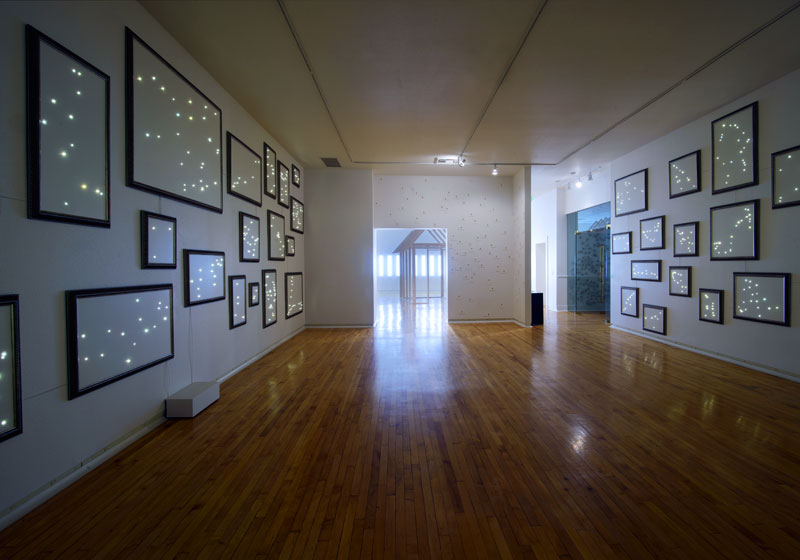
Tamara Scronce, Installation View (2014), E. L. Wiegand Gallery
Today, the Art Center includes a 350-seat proscenium theatre, which has been described as the finest small performing arts house in Nevada, and over 3,000 square feet of gallery/exhibition space. The building has dramatically augmented CAC’s efforts to enhance the cultural and social life of the community and region by providing educational and experiential opportunities in the arts on a variety of levels.
Some of the performers who have taken the stage recently include the classical violinist Midori; the contemporary chanteuse Storm Large and her ensemble, Le Bonheur; the legendary singer-songwriter Guy Clark; R&B vocalist Bettye Lavette; jazz greats Joe Lovano, Esperanza Spalding, and Patricia Barber; and many, many others.
CAC’s programming and its efforts in transforming the building have been recognized by receipt of a Tourism Development Award from the Nevada Commission on Tourism, the Governor’s Arts Award for Service to the Arts, and receipt of major funding from the National Endowment for the Arts. There has also been significant support from national foundations such as the Andy Warhol Foundation for the Visual Arts. The Center itself was named Hidden Treasure of the Year by the Nevada Travel Network.
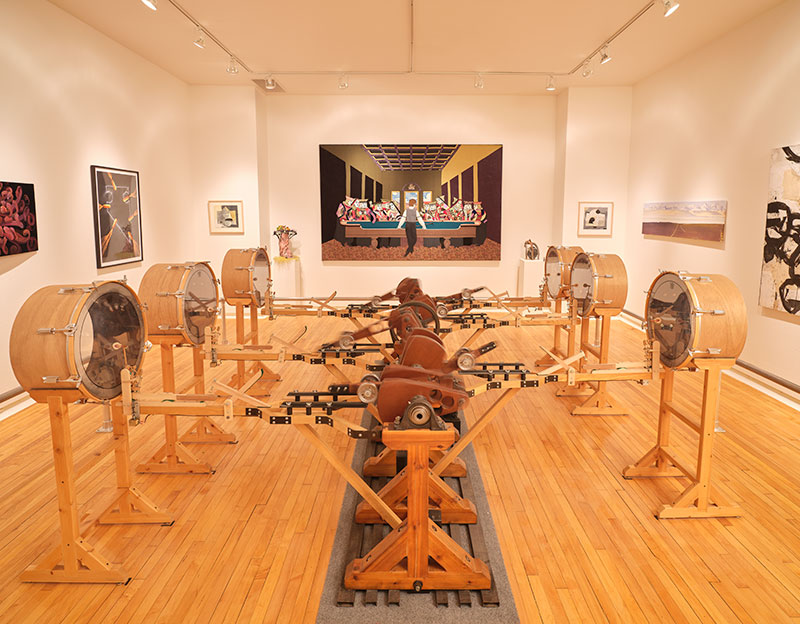
Crank Gallery, Oats Park Art Center, Fallon, Nev.
The $7.5 million renovation and adaptive re-use of the Oats Part Art Center was funded from an array of sources, including: the E. L. Wiegand Foundation; the Nevada Commission for Cultural Affairs; Bill & Harriet Barkley; Save America’s Treasures; the E. L. Cord Foundation; the Bretzlaff Foundation; the Jon Ben Snow Memorial Trust; the Robert Z. Hawkins Foundation; the Nevada Arts Council; the National Endowment for the Arts; and many other organizations and individual donors. Returning the structure to community use continues to have emotional resonance in Fallon, as a majority of residents age 25 and older attended school there.
Through innovative programs, and its ongoing commitment to build and maintain a permanent home for the arts and cultural activities in Fallon, the Churchill Arts Council believes that the Oats Park Art Center will have as prominent a place in Fallon’s future as the Oats Park School did in its past.
We hope to see you all down the road at some of our future programs.












